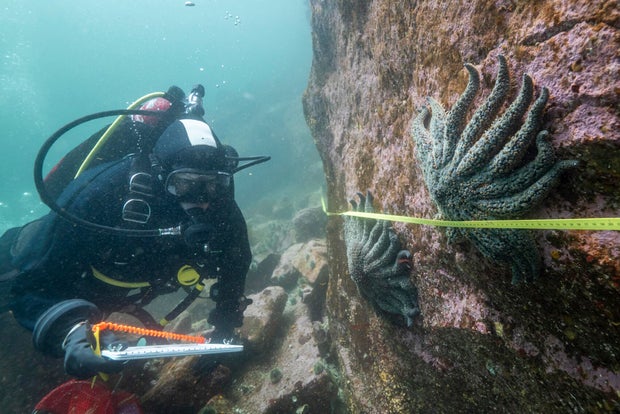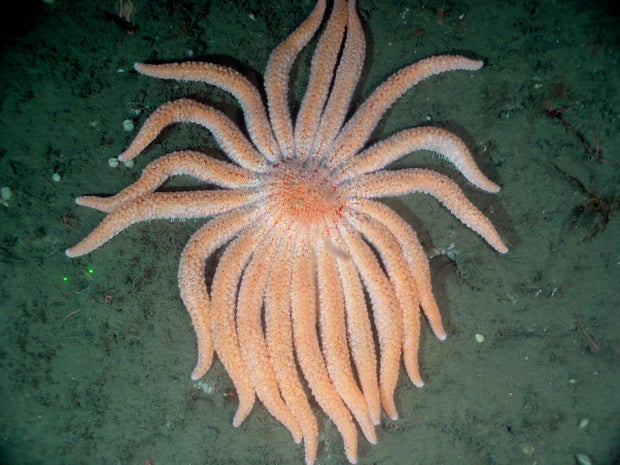
Scientists say they have at last solved the mystery of what killed more than 5 billion sea stars – often known as starfish – off the Pacific coast of North America in a decade-long epidemic.
Starting in 2013, a mysterious sea star wasting disease sparked a mass die-off from Mexico to Alaska. The epidemic has devastated more than 20 species and continues today. Worst hit was a species called the sunflower sea star, which lost around 90% of its population in the outbreak’s first five years.
“It’s really quite gruesome,” said marine disease ecologist Alyssa Gehman at the Hakai Institute in British Columbia, Canada, who helped pinpoint the cause.
Healthy sea stars have “puffy arms sticking straight out,” she said. But the wasting disease causes them to grow lesions and “then their arms actually fall off.”
The culprit? Bacteria that has also infected shellfish, according to a study published Monday in the journal Nature Ecology and Evolution.
Bennett Whitnell/Hakai Institute via AP
The findings “solve a long-standing question about a very serious disease in the ocean,” said Rebecca Vega Thurber, a marine microbiologist at University of California, Santa Barbara, who was not involved in the study.
Sea stars typically have five arms and some species sport up to 24 arms. They range in color from solid orange to tapestries of orange, purple, brown and green.
“Symptoms of sea star wasting syndrome include abnormally twisted arms, white lesions, deflation of arms and body, arm loss, and body disintegration,” the National Park Service says. “They die over the course of days or weeks.”
It took more than a decade for researchers to identify the cause of the disease, with many false leads and twists and turns along the way.
Early research hinted the cause might be a virus, but it turned out the densovirus that scientists initially focused on was actually a normal resident inside healthy sea stars and not associated with disease, said Melanie Prentice of the Hakai Institute, co-author of the new study.
Other efforts missed the real killer because researchers studied tissue samples of dead sea stars that no longer contained the bodily fluid that surrounds the organs.
But the latest study includes detailed analysis of this fluid, called coelomic fluid, where the bacteria Vibrio pectenicida were found.
“It’s incredibly difficult to trace the source of so many environmental diseases, especially underwater,” said microbiologist Blake Ushijima of the University of North Carolina, Wilmington, who was not involved in the research. He said the detective work by this team was “really smart and significant.”
Now that scientists know the cause, they have a better shot at intervening to help sea stars. The International Union for Conservation of Nature has listed the sunflower sea star as critically endangered.
Universal History Archive/Universal Images Group via Getty Images
Prentice said that scientists could potentially now test which of the remaining sea stars are still healthy — and consider whether to relocate them, or breed them in captivity to later transplant them to areas that have lost almost all their sunflower sea stars.
The study notes that Vibrio bacteria have been called “the microbial barometer of climate change” because the species are more prevalent in warming water temperatures. The authors say an important next phase of research will be to work on better understanding the relationship between rising seawater temperatures and sea star wasting disease.
Scientists may also test if some populations have natural immunity, and if treatments like probiotics may help boost immunity to the disease.
Such recovery work is not only important for sea stars, but for entire Pacific ecosystems because healthy starfish gobble up excess sea urchins, researchers say.
Sunflower sea stars “look sort of innocent when you see them, but they eat almost everything that lives on the bottom of the ocean,” said Gehman. “They’re voracious eaters.”
With many fewer sea stars, the sea urchins that they usually munch on exploded in population — and in turn gobbled up around 95% of the kelp forest s in Northern California within a decade. These kelp forests provide food and habitat for a wide variety of animals including fish, sea otters and seals.
Researchers hope the new findings will allow them to restore sea star populations — and regrow the kelp forests that Thurber compares to “the rainforests of the ocean.”



